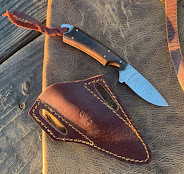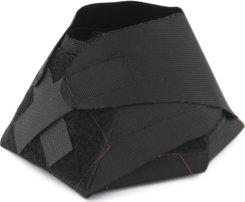When we started with ground work on Monte, I introduced him to following a feel on the lead rope moving to be able to control a foot with the lead rope and now in the saddle with a snaffle bit outfit, I continued that with asking him to step out with a front leg. With more of a horse's weight on their front feet, often when you ask the horse to walk off either straight or at an angle, a front foot may move forward and it seems like a stumble or a hard step and sometimes it seems like the back end is an after thought or follows like being pulled forward.
So for much of when I ask for forward movement after I throw a leg over a horse, I ask for the horse to step to out to the side a front foot. In the beginning it helps to rock a horse back so his body weight is shifted some to the hind end. This is much like a human rocking weight to one leg/foot in order to push off with that foot and step out with the other. Putting a change, even a small change, of the weight on the hind end makes it easier for the horse to pickup a front foot and place it out.
I think of it as picking that foot up with a direct rein, much like I did on the ground with the lead rope, and placing that foot outside and to the front. This is the beginning of a turn on the haunches and is going to help you be able to do turn arounds on the horse. With a horse having a difficult time picking a front foot up and out, it is sometimes beneficial to back the horse a step and as a hind foot makes contact with the ground going back an a front foot will be doing the same (as they back in the two beat foot fall pattern). Then ask for the front foot that is coming off the ground to step out. Certainly some will try to get a front foot to step out thinking it has to do so on a particular back foot making contact with the ground, either the same side hind or the opposite hind. I think both are actually correct. On turn arounds with forward momentum, I leave it to the horse to choose that hind foot but if he is sluggish, I'll often stop, back a step then ask for the turn, much like a roll back. But I getting ahead of myself, Monte was in the beginning of picking up a front foot and placing it out on an ask with the rein.
Onto side passing. This is something I'll normally work on later in a horse's development, I am including it for two reasons. 1 - because a lady wrote me a week before I re-started Monte asking for help in getting her and her mare to side pass, and 2 - Monte was getting capable at side passing as I had pretty good early control of his head and neck, front end and hind end which are all necessary to being able to side pass. I wanted him to have a basic understanding of this before he was shipped out.
In clinics I'll ask riders want they want to work on. When I get a response like, "I'd like to be able to side pass or open gates", I get the rider's to work on control over head and neck (lateral flexion and vertical softness), and moving front end independently from the hind end and vice versa. Sometimes I'll get a comment like, "I already do that, I'd just like to work on side passing". Invariably, or at some riders and their horses don't have an understanding of asking for the independent movements of those parts of the horse. Otherwise they would be better prepared to side pass and open gates.
When you ask for a side pass using your leg (calf) right behind the front cinch (think of it as stirrup position 2) the horse not understanding at first will likely move either the front end or the hind end over first. As the horse moves sideways, the front end or the hind end may lag behind hence being able to control and move the lagging part to catch up is necessary. The more you do this, the smoother the horse will get. In the beginning only asking for a small side pass and build on that and later don't be greedy and ask the horse to side pass 30 yards. Stop asking before the horse gets dull.
The side pass without checking the horse's forward movement or asking for continuous forward movement becomes a leg yield. That is sideways movement with forward momentum. This is also called two tracking. That would be another understanding for the horse and valuable as you can control the position of the horse much better and useful in everything from to controlling better and rounder circles, to leg yielding or getting forward lateral movement towards a gate or around an obstacles, to keeping a horse looking at something like a calf while you position his body with lateral movement.





















